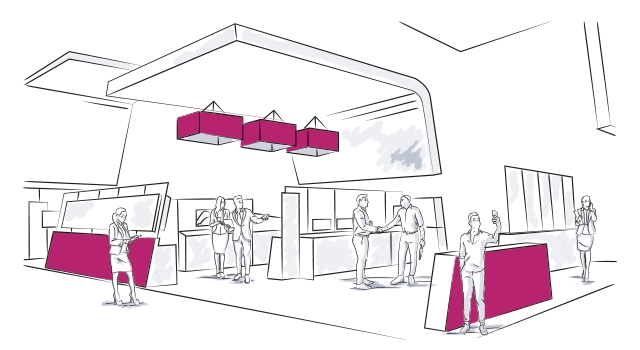
Monday Motivation: How to Plan a Successful Large-Scale Event, No Stress
Your task as a corporate planner is never a piece of cake, but large-scale events present unique challenges. Industry trade shows. Product launches. Professional conferences. If all events are puzzles, large-scale events are the thousand-piece ones, and every piece is a shade of the same color. They require an extra measure of planning, coordination, and event management grit.
Strengthening your skillset is essential in our industry, but never more so than with large-scale events. Read on to learn tips for managing the common stumbling blocks of large events, as well as strategies to make sure large groups of attendees get where they need to go”safely and on-time.
- What exactly is a large-scale corporate event?
- Tips for large-scale corporate event planning
- Large-scale event checklist
- Keys to managing large groups of people
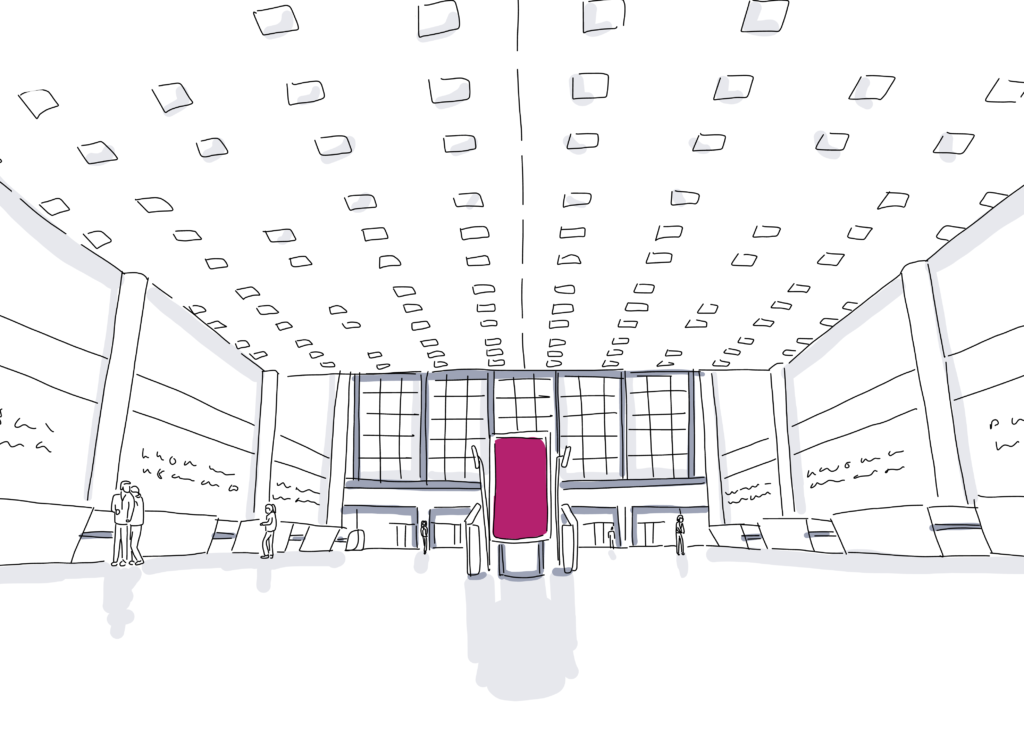
What exactly is a large-scale corporate event?
There’s no exact industry standard or guest number threshold that makes an event go from regular to large-scale. But large scale events are defined by large numbers of guests in the hundreds, thousands, or even tens of thousands. And they are complex. These aren’t one-offs in a single space. They require coordination in multiple event spaces, often over several days.
Examples of large-scale events:
- New product launches (e.g., SaaS, tech hardware, apps, consumer packaging)
- Industry conferences (e.g., digital media conference, electronics conference)
- Global company holiday parties, or employee appreciation events
- Professional seminars (networking and professional development)
Some large-scale events are widely covered in the media, such as Apple’s new product launches and the annual Consumer Electronics Show (CES). But corporate events are happening all the time, around the globe”and they take rockstar planning chops to pull off.
Since you already know how to plan an event, we’re offering up creative strategies to help you improve your process and keep your team on task.
7 out-of-the-box tips for large-scale corporate event planning:
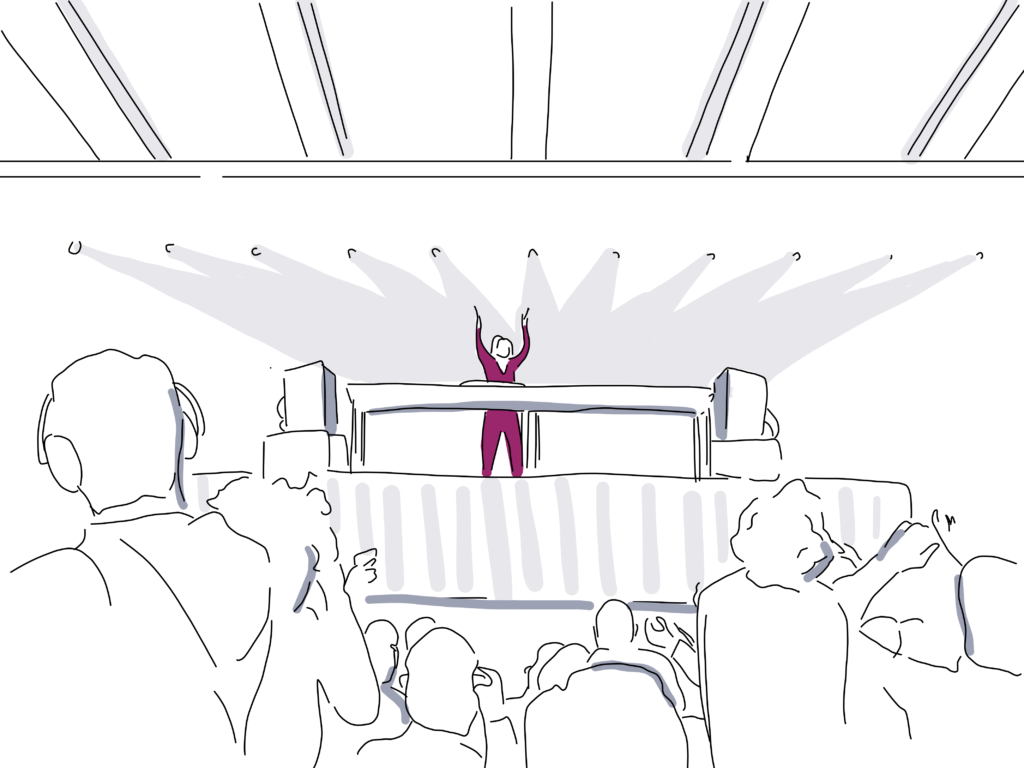
1. Get on the same page with stakeholders
Not everyone in your company or your client’s organization will have the same sense of urgency as you and your team. But to pull off a massive event, everyone needs to share the same goal and orient in the same direction. Otherwise, important budget approvals and last-minute decisions may not get addressed promptly.
Connect with your core team of decision-makers early in the process. Share images and creative inspiration, possible speakers, and venues to foster engagement and excitement about the result. Let them know you’ll send out periodic progress reports (once per week or every two weeks) that share finalized contracts and design updates. These emails can also include pressing questions that require answers, and any authorizations you’re awaiting.
[Tweet “If all events are puzzles, large-scale events are the thousand-piece ones, and every piece is a shade of the same color.”]
2. Lock down the date”ASAP
This is always essential in event planning, of course. But when the event scope is large, your venue options narrow somewhat and it’s especially important to lock down the date.
Reach out to top executives of the organization (or organizations) planning the conference first. You’ll be communicating with their executive assistants primarily; establish friendly and respectful relationships with them. They are your connection to essential players, and administrators of the all-important planning calendars.
Once you have the date set, you can start to reach out to workshop leaders, speakers, and celebrities. Have several outstanding options for each type of VIP”their calendars fill up fast and early.
For the most part, your headlining presenters will be subject matter experts for the conference’s focus. But for large-scale events, you may have a ˜just for fun’ element that is a perk for attendees. For example, a business conference may offer a cooking demonstration and a massive tasting led by a Michelin Star chef is the event’s show-stopper. You need to narrow down dates so you can win that contract.
3. Communicate, communicate, communicate
Large-scale event planning requires multiple teams working on different elements. Too many critical pieces of information can fall through the cracks when you expect communication to happen without clear parameters. Here are some helpful communication strategies that keep everyone on the same page:
- Establish a schedule for team check-ins during the planning process. Whether by conference call or in-person, everyone should use this time to update the team on completed tasks, pressing issues, concerns, and coordinate next steps.
- Give the right people access to key events in your event planning software. There may be multiple events to track at once: Keynote speech and Q&A. A product rollout. Networking breakouts. The closing gala dinner. Make sure essential team members can add details to the event when needed. This may be in-house planners, or guest collaborators, such as an outside stage design company who can add the layout, or the venue manager who can add the table layout for the ballroom buffet dinner.
A word of caution: Be choosy about sharing an event to avoid mistakes and confusion. Give ˜Can Edit’ access to team members with authorization to add design elements or make changes, and give ˜Can View’ access to all others.
- Discuss dietary restrictions, allergies, and ADA compliance. These are important and require special attention during an ˜all-hands-on-deck’ meeting a month or so before the event.
4. Make sure the venue and location supports the event goal
Large-scale events often require sites with multiple-use spaces. If your event features speakers and panel discussions, source venues with two or more large auditorium spaces. These allow for a large number of attendees, and the theater-seating ensures they can see the speakers and any video or slide presentations.
If your event will also feature smaller networking meet-and-greets, and breakout learning sessions on niche subjects, make sure the venue has a variety of mixed-use spaces, such as conference rooms and lounges.
Do you hope to attract attendees from around the world? Choose a location with some tourism appeal”people like to combine conferences with sightseeing and local excursions when they can.
If your large event has a smaller-than-ideal budget, source venues in small towns and cities. These can be more affordable, and often deliver small-town charms that attendees appreciate.
5. Gather your team and make sure their strengths cover the needs of this event
Each of your team members brings different strengths and weaknesses, and different areas where there is room for growth. Play to your team’s unique abilities and work styles. Some enjoy outreach to speakers and vendors. They can check-in with contacts, coordinate schedules, and get the answers you need”and they pull it off without being obnoxious. Give your most creative team members the responsibility for the closing dinner theme, or background music selection.
When possible, give employees opportunities to push beyond their comfort zone. This helps you develop a more well-rounded team over time, and raises morale. Research shows employees are happiest when learning new skills and advancing their careers.
Finally, keep varied learning and communication styles in mind. Some team members work best when reviewing layout changes on your shared event software, others work best with a PDF printout of the layout. Hold a combination of email and in-person updates, because some employees will prefer one over the other.
6. Be prepared to say no when necessary
Your CEO wants A,B, or C, but their ˜ask’ is logistically challenging or will require other sections of the event get short shrift? It’s time to”very politely”set expectations, and explain the limitations of the space or the timeline. You may also need to say no to speakers and presenters who want to expand their time, or expect an A/V setup that is beyond the scope of the vendor contract.
Saying no is a skill that takes practice. Really! As an event planner, you may be a people pleaser, or you may be moving so fast all the time that you say yes to things on the fly”only to have to jump through hoops to make it happen. Commit to pausing before responding to three requests per week. Ask yourself if the request is vital to the event, or promotes the event goal? If it doesn’t, tell the request-maker no gently, but firmly with a brief explanation.
7. Expect”and plan for”the unexpected
The more moving pieces? The higher the chances something will go wrong. Brainstorm worst-case scenarios with your team and come up with a Plan B that addresses each one. When something goes wrong, you’ll have a solution at the ready. Here are a few examples:
Problem 1: A blizzard grounds a conference guest speaker’s flight.
Plan B: Substitute a Q&A session with thought leaders within the company hosting the event. Chances are they will be involved in other speeches and conversations during the conference, just make sure their schedule is clear during the guest speaker’s time-slot. Pick a subject related to the meeting and that offers real benefit for attendees. Let the Q&A participants know the questions in advance.
Problem 2: You lose wifi before a seminar including a live-streamed speaker from a remote location, or live-streaming to people who couldn’t make it to the conference.
Plan B: Presenters should produce hard copies of essential video presentations for the event. If they can’t live-stream to the remote speaker, they’ll have something to fall back on. Have an update email ready to send to the live-streaming audience if there are technical issues, and record the event so you can share it with them after the fact.
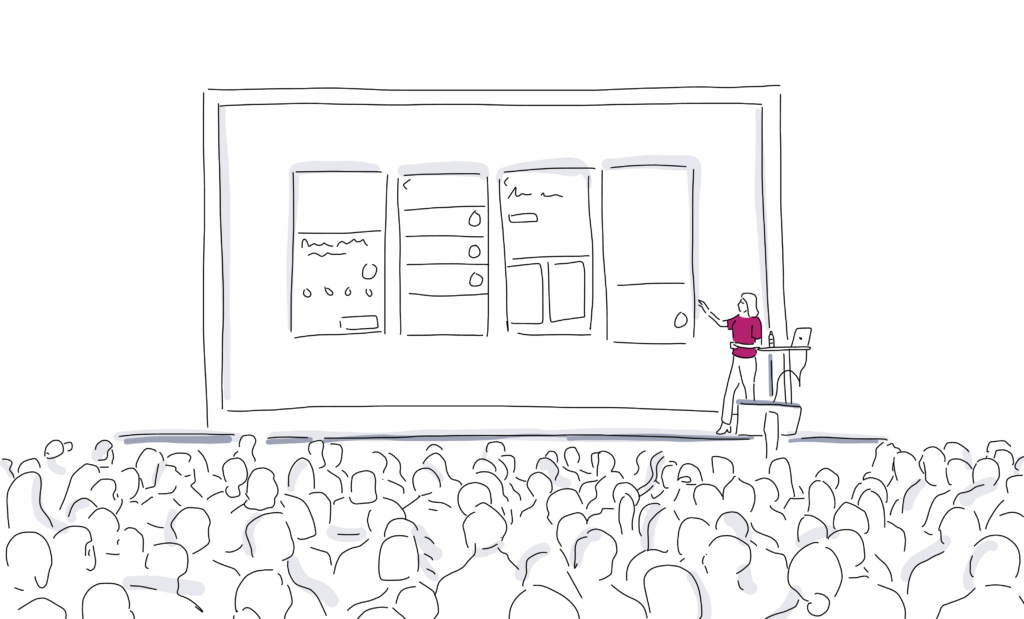
Large-scale event checklist
The lead time for large-scale event planning is long, so it’s helpful to break your tasks across a year (or more!) before the event. Your large-scale event planning timetable should look something like this:
12 to 16 months prior to the event
- Establish objectives, including the purpose of the event, the event value proposition, and the target attendance.
- Set the date.
- Establish a budget and update it regularly as you go.
- Choose an event format or a theme.
- Book the venue.
- Research speakers.
- Launch your event marketing campaign.
- Determine if you want sponsorship for your event, and reach out. Choose sponsors that align with your company and your attendees.
8 to 11 months prior to the event
- Finalize speaker contracts, and get them signed.
- Create the venue layout – use event diagram software to make things easier.
- Finalize venue details – ensure you have A/V equipment and Wi-Fi, adequate parking, security, accessibility features.
- Review and finalize budget.
3 to 7 months prior to the event
- Finalize the menu, working with the caterer to ensure all dietary requirements are met.
- Manage speaker travel arrangements.
- Get speaker bio info and photos.
- Make sure all contracts are signed.
- Get all permits, licenses, and event insurance.
- Order event merchandise and promotional materials.
- Collect and make final payments.
- Put together a draft of the event schedule.
1 to 2 months prior to the event
- Organize a visit to the venue for the team to do a walk-through.
- Send reminders to attendees on email and social media.
- Check in with speakers and panelists to see if they have questions or concerns.
- Push last-minute prospective attendees to register.
- Review event materials, including programs, the event app, and branded swag.
Week of the event
- Confirm vendor arrival set-up and break-down details.
- Provide final registration numbers to the venue and caterer.
- Double-check the A/V equipment and wifi.
- Train volunteers, greeters, and hosts.
- Final venue walkthrough.
1 day to 2 weeks after the event
- Send post-event survey to attendees.
- Send thank-you notes to volunteers and speakers (as well as donors and sponsors, if applicable).
- Debrief the team. Discuss post-event survey results, what went well, and what you will improve on next time.
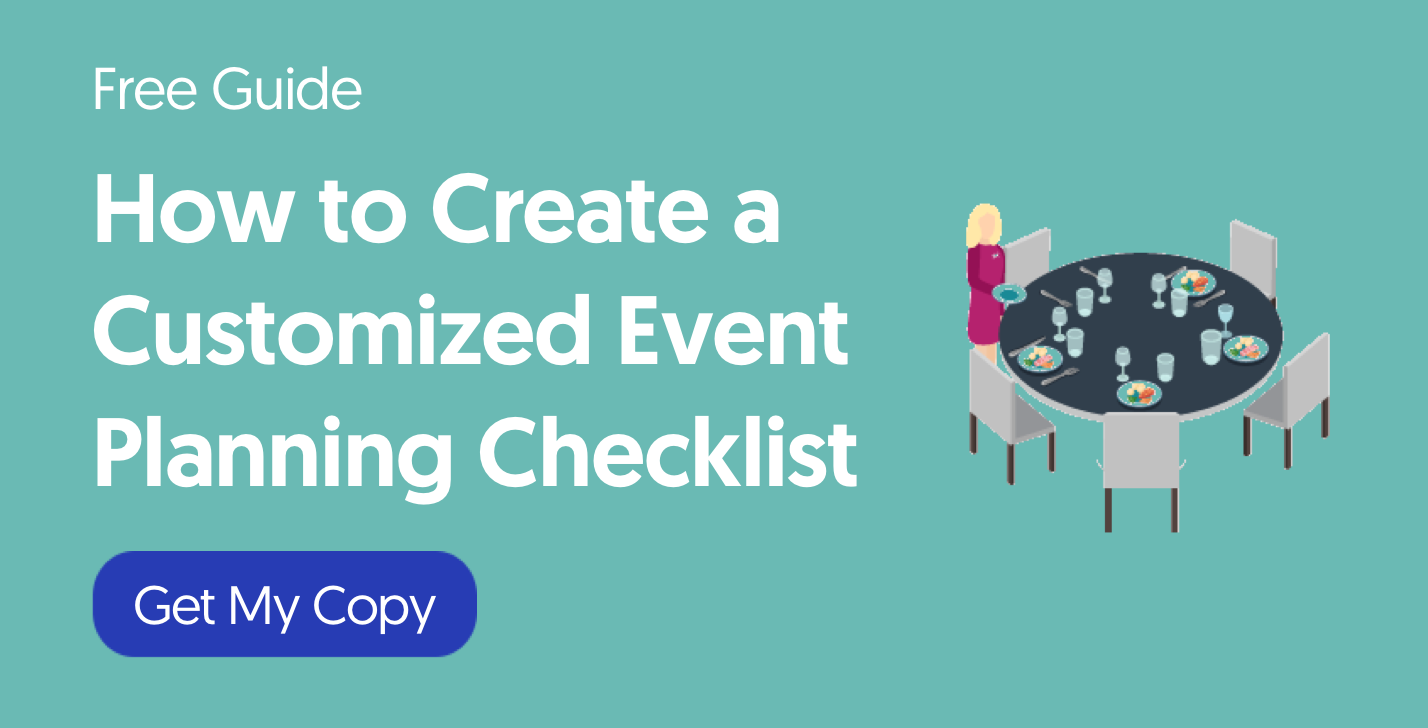
3 critical keys to managing large groups of people
Crowd easement is a key element of large-scale event planning. You need to consider how you’ll get large groups of people from one event to the next, safely and smoothly. Here are three essential pieces of the crowd management puzzle for you to put in place as you plan a large-scale event.
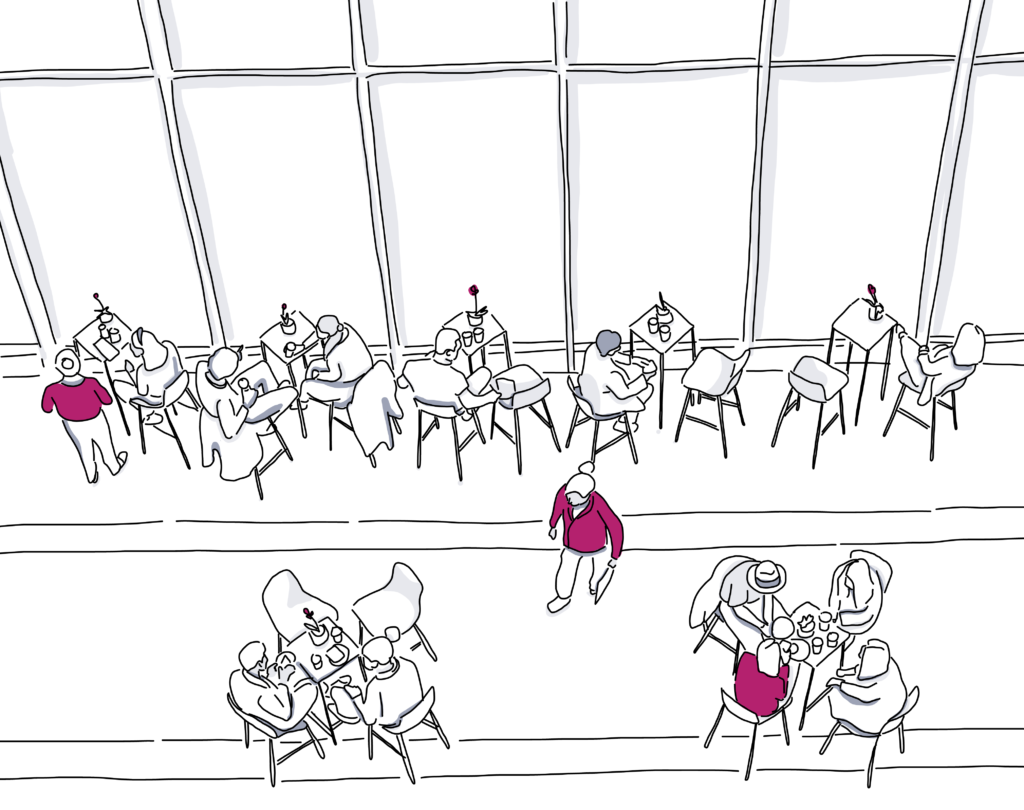
1. Streamline the check-in and registration process
When people wait a long time for anything, they become frustrated. Standing on their feet, waiting in a long line to check in to your venue is one way to ensure that a few tempers will flare. This can dampen the upbeat mood you’ve worked to create at the event, leading to a negative experience before the first speaker takes the stage.
Prior planning is crucial to keep the lines moving smoothly. A few ways to avoid lines, bottlenecks, and frustrated guests include:
- Multiple points-of-entry where attendees can show their ticket and pass through.
- A check-in app for quick event registration.
- Turnstyles, barcode scanners, or RFID technology (e.g.,bracelets, key fobs).
- Self check-in kiosks.
- An information services desk to cope with more challenging problems without holding up the line.
If you plan on doing bag checks, ensure that security staff is adequately prepared so they can keep people moving along. Train your staff well on the benefits of kindness, understanding, and patience. A little compassion can diffuse a tense situation.
2. Communicate with the crowd
The first step in clear communication is proper signage placed around the venue. When people know where to go, they’ll keep moving to get there. You can use fixed signage in some areas and LED boards that provide updates in others. Position signs so that they are easy to see from multiple vantage points. Clearly marked areas should include:
- Restrooms
- Smoking areas
- Staff-only areas
- Registration areas
- Potential hazards
You can also distribute small maps of the conference venue (or venues), or post large maps in the entrance and halls. Have enough ushers and hosts circulating through the crowd to assist people who have questions. If the venue is large, consider using a PA system for announcements. And a well-staffed information desk is always helpful.
3. Design detailed emergency and crowd-safety plans
At large scale events, it’s particularly important to have clear emergency plans. From natural disasters to stage fires to power outages to fights, it’s essential your planning team and the security team discuss every eventuality. Key safety precautions for large crowds include:
- A walkthrough just prior to the event to ensure emergency exits are open and clear of blockages.
- Establish shared language and signs that let all team members and security personal instantly understand there is a problem and the location of the problem.
- A test of the emergency lighting system and backup generator so attendees can find their way out if the power goes out.
- A person trained to navigate the PA system in the event of an emergency.
- Personnel stationed near areas at risk of bottlenecks to facilitate crowd flow.
- Security personnel near main exits.

Ready to get a large team on the same page for your next large-scale event?
Learn how event planning software keeps everyone up to date”whether they’re on a site visit or meeting with vendors. Or, fine-tune your event planning skills even further with these time-saving event planning tips.
Some quick answers about large scale events:
Complex events with thousands of attendees that take place over multiple days and/or locations can safely be considered large scale events.
The keys to organizing large scale events are high levels of communication, long event planning timelines, a reliable team, and unbridled creativity.

